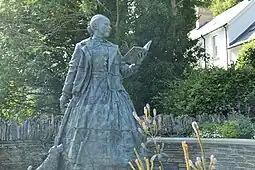Sarah Jane Rees
Sarah Jane Rees (9 January 1839 – 27 June 1916), also known by the bardic name "Cranogwen", was a Welsh teacher, poet, editor, master mariner and temperance campaigner.[1] She had two romantic friendships with women, first with Fanny Rees, until her death from tuberculosis, then with Jane Thomas, for most of the rest of Rees's life.
Sarah Jane Rees | |
|---|---|
_NLW3362516.jpg.webp) Rees, about 1875 | |
| Born | 9 January 1839 Llangrannog, Wales |
| Died | 27 June 1916 (aged 77) Cilfynydd, Wales |
| Burial place | St Crannogs, Cilfynydd |
| Occupations |
|
| Era | Victorian era, Edwardian era |
| Organization | South Wales Women's Temperance Union (UDMD) |
Early life
Sarah Jane Rees was born at Llangrannog in Cardiganshire, the daughter of mariner John Rees. She received early education at the village school.[2] A precocious child, she insisted she must accompany her father to sea rather than do sewing and cooking chores at home, which she hated.[3] However, this was not so unusual: many wives and daughters accompanied men in local ships, trading up and down the coasts on family business.[4]
Rees was initially educated locally by an old schoolmaster called Hugh Davies, who taught her Latin and astronomy.[1][2] She later attended school in Cardigan and New Quay, and for a time studied at a navigation school in London,[2] where she gained her master's certificate, a qualification allowing her to command a ship in any part of the world.[5]
In 1859 Sarah Jane set up her own navigation school in her home village of Llangrannog.[6]
Career
In 1865, competing at Aberystwyth against men such as William Thomas (Islwyn), she won her first major Eisteddfod prize, for "Y Fodrwy Briodasol (The Wedding Ring)", in the Song category.[2] A book of poems, Caniadau Cranogwen, followed this in 1870.[7]
Rees went on a tour of Wales in 1866–1867, giving lectures with a charge of 6d for a ticket. The profits from the sales to large audiences paid off debts for several chapels. The audience in the Brynhyfryd Chapel in Swansea numbered nearly 1,000 people.[8]
She gave a lecture entitled Yr Ieuengctyd a Diwylliant eu Meddyliau (transl.The young, and the culture of their minds) at the Independent Chapel, Brynmenyn on 2 January 1867, and an admission ticket from the event is preserved in the collections of Amgueddfa Cymru, National Museum Wales.[9][8]
While teaching navigation and other subjects, she also became editor of the Welsh-language women's periodical Y Frythones (1878–1889), a "platform for Welsh bluestockings and proto-suffragettes".[10][11] In 1869–1870, she toured the United States, addressing mainly Welsh emigrant communities as far west as California.[12] She was one of the founders of the South Wales Women's Temperance Union (UDMD) in 1901, and by her death in 1916 there were 140 branches throughout South Wales.[13][8]
Personal life

Rees had two significant same-sex relationships, previously described as romantic friendships.[14] Her first was with Fanny Rees (1853-1874), a milliner's daughter from Troedyraur, near Llangrannog. Rees called Fanny “Phania” but she contracted tuberculosis and returned to Wales around 1874 to die. She moved into Rees' home rather than that of her family, and died in her arms. Rees was so affected that for 12 years she was unable to put flowers on Fanny's grave. She commemorated Fanny in one of her best-known poems, Fy Ffrind (My Friend).[15]
Her second relationship, with Jane Thomas (1850-?), lasted for most of her life.[8] Open about this unconventional arrangement, Rees still remained a committed Methodist and toured giving lectures on education, temperance and other subjects.[13]
Rees died on 27 June 1916 at Cilfynydd[16] and was buried in St Crannogs churchyard, where her grave was marked by a large elaborate obelisk.[17][18]
Legacy

A shelter for homeless women and girls, Lletty Cranogwen was founded in the Rhondda valley in 1922 by the South Wales Women's Temperance Union and named to mark Rees's work to improve Welsh women's lives.[1][19]
There is a fisheries patrol vessel used by the Welsh Government based in Milford Haven that has been named after Cranogwen.[20]
In 2019 Rees was among five women shortlisted as the subject for an artwork to be installed in Cardiff.[21] In December 2021 Sebastien Boyesen was commissioned to create a figurative sculpture of Cranogwen in Llangrannog, the third commissioned by the Monumental Welsh Women statue campaign.[22][23] The statue was unveiled in a ceremony commemorating her life on 10 June 2023.[24][25]
References
- "Rees, Sarah Jane". Dictionary of Welsh Biography. National Library of Wales. 1959. Retrieved 31 January 2016.
- "Noted Welshwoman: Death of Cranogwen". The Cambrian News. 30 June 1916. Retrieved 1 January 2016.
- John (1991), p. 80.
- Norena 'Cranogwen' Shopland, Forbidden Lives: LGBT stories from Wales Seren Books (2017).
- Deirdre Beddoe: "Rees, Sarah Jane..." ODNB Retrieved 9 January 2019.
- Shopland, 2017.
- Carradice, Phil (25 April 2013). "Sarah Jane Rees, Schoolteacher and Poet". BBC Wales. Retrieved 31 January 2016.
- "Touring with Cranogwen". Museum Wales. Retrieved 24 February 2023.
- "Admission ticket". National Museum Wales. Retrieved 14 April 2022.
- Jenkins, Geraint H. (2007). A Concise History of Wales. Cambridge University Press. p. 220. ISBN 9780521823678.
- "Welsh Women Writers (1700–2000), in John T. Koch, ed., Celtic Culture: A Historical Encyclopedia (ABC-CLIO 2006): 1787.
- Hughes, David (1969). Welsh People in California, 1849–1906. R & E Research Associates. p. 119.
- Deirdre Beddoe, Out of the Shadows: A History of Women in Twentieth-Century Wales University of Wales Press, 2000, p. 38.
- Davies, Russell (2005). Hope and Heartbreak: A Social History of Wales, 1776–1871. Cardiff: University of Wales Press. p. 320. ISBN 9780708319338.
- Norena Shopland, 2017.
- Obituary, Cymru 1914, 30 June 1916. Accessed 16 September 2014.
- Barnes, David (2005). The Companion Guide to Wales. Companion Guides. p. 30. ISBN 9781900639439.
- "Image of the Cranogwen Memorial at Llangrannog churchyard". Ceredigion County Council. Retrieved 31 January 2016.
- Rhondda Cynon Taf Libraries Digital Archive, "Mrs M Griffiths JP, opening 'Lletty Cranogwen', 144 Kenry Street, Tonypandy, 21st June 1922" (photograph).
- At sea resources Welsh Government, 2020
- Hitt, Carolyn (9 January 2019). "Hidden Heroine: Could Cranogwen win statue?". BBC News. Retrieved 10 January 2019.
- "Sculptor Sebastien Boyesen to create statue of legendary Cranogwen". Tivyside Advertiser. Retrieved 1 December 2021.
- "Sculptor chosen to create Cranogwen statue in Llangrannog". ITV News. 1 December 2021. Retrieved 1 December 2021.
- "Unveiling – Cranogwen". Retrieved 1 May 2023.
- "Swashbuckling poet Cranogwen is third woman in Wales to get statue". BBC Wales. 10 June 2023. Retrieved 11 June 2023.